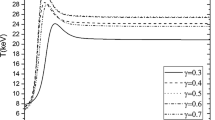Abstract
The original Lawson concepts (amplification factorR and parameternτ as well as their applications in DT reactors are discussed in two cases: the ignition regime and the subignition regime in a self-sufficient plant. The modified Lawson factor or internal amplification factorR α (a function of alpha power) is proposed as a means to measure the ignition level reached by the plasma, in a more precise way than that given by the collective parameter (nτkT). The self-sufficiency factor (δ) is proposed as a means to measure the plant self-sufficiency,δ being more significant than the traditionalQ factor. It is stated that the ignition regime (R α =1) is equivalent to a critical state (energy equilibrium); then, the corresponding critical mass concept is proposed. The analysis of theR α relationship with temperature (kT), (nτ), and recirculating factor (ɛ) gives the conditions for the reactor to reach ignition or for the plant to reach self-sufficiency; it also shows that an approach to ignition is not improved by heating from 50 to 100 KeV.
Similar content being viewed by others
References
J. D. Lawson,Proc. Phys. Soc. London Sec. B.,70, 8 (1957).
S. Rippon,Nuclear News,29,10, 70 (1986).
G. L. Kulcinski and E. Bertolini,Nuc. Fus.,26, 1380 (1986).
P. J. Persiani, W. C. Lipinski and A. J. Hatch, inThe Technology of Controlled Thermonuclear Fusion Experiments and The Engineering Aspects of Fusion Reactors, Proceedings of a Symposium, Austin, Texas, 1974, p. 348.
D. L. Galbraith and T. Kamash, inThe Technology of Controlled Thermonuclear Fusion Experiments and The Engineering Aspects of Fusion Reactors, Proceedings of a Symposium, Austin, Texas, 1974, p. 16.
T. J. Connolly,Fundamentos de Ingeniería Nuclear (Editorial Limusa, México, 1983), p. 335.
F. L. Ribe,Rev. Mod. Phys.,47, 14 (1975).
M. O. Hagler and M. Kristiansen,An Introduction to Controlled Thermonuclear Fusion (Lexington Books, Lexington, 1978), p. 29.
H. Furth, T. Kenneth Fowler, and H. Dreicer,J. Fus. Energy,4, 101 (1985).
R. L. Murray,Nuclear Reactor Physics (Prentice Hall, Englewood Cliffs, New Jersey, 1957), pp. 52, 68, 101, 118.
J. Lartigue,Ener. Nucl. 23, 343 (1979).
J. Lartigue, inApplied Simulation and Modelling, Proceedings of the IASTED International Symposium, Montreal, 1985, p. 338.
M. O. Hagler and M. Kristiansen, inApplied Simulation and Modelling, Proceedings of the IASTED International Symposium, Montreal, 1985, p. 119.
Y. Nakamura, M. Wakatami, S. Yoshimura, and A. Ilyoshi,Nuc. Fus.,27, 159 (1987).
F. L. Ribe,Nuc. Fus.,27, 9 (1987).
Author information
Authors and Affiliations
Rights and permissions
About this article
Cite this article
Lartigue, J.G. Lawson concepts and criticality in DT fusion reactors. J Fusion Energ 6, 413–420 (1987). https://doi.org/10.1007/BF01052076
Received:
Issue Date:
DOI: https://doi.org/10.1007/BF01052076




